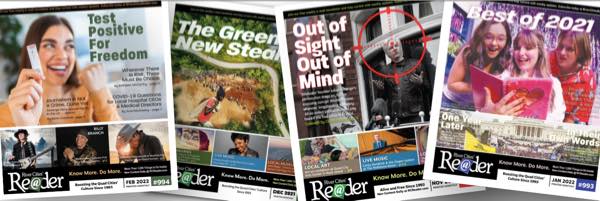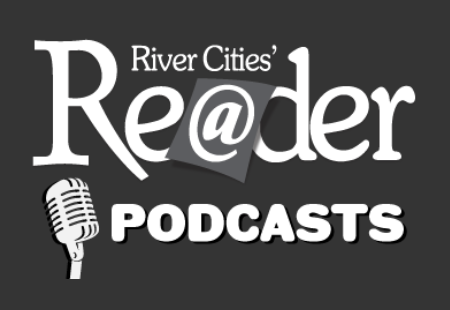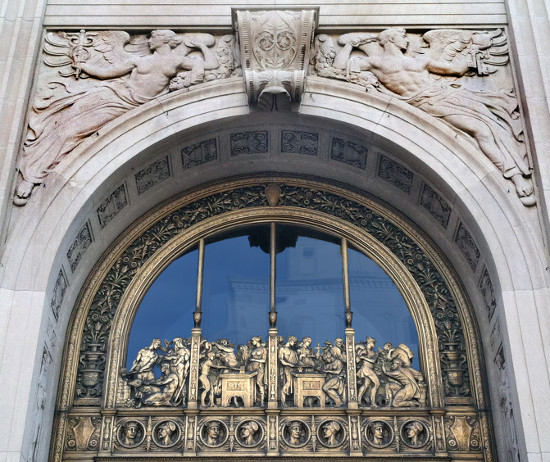
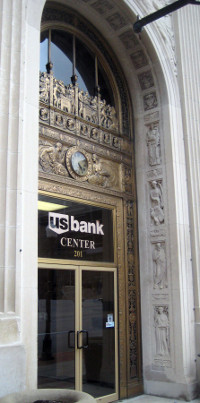 The entrance to the First National Bank Building (now U.S. Bank) at 201 West Second Street in Davenport tells the story of commerce and banking through classical images and symbols. The ancient Greek and Roman references and high artistic level of the entrance tell us, in effect, that banking is an important institution - one of the cornerstones of Western civilization and a pillar of the community.
The entrance to the First National Bank Building (now U.S. Bank) at 201 West Second Street in Davenport tells the story of commerce and banking through classical images and symbols. The ancient Greek and Roman references and high artistic level of the entrance tell us, in effect, that banking is an important institution - one of the cornerstones of Western civilization and a pillar of the community.
The entrance is primarily composed of three parts: an intricately cast bronze doorway, two reclining life-sized figures carved in stone above the doorway, and four smaller figures in the stone reveal on both sides of the doorway. Collectively, the three parts create an impressive and unified whole.
Standing 21 feet tall, the bronze doorway is the visual focus of the building. Images include figures and objects from ancient Greek coins and images of Hermes (or the Roman Mercury), the protector of commerce. The central clock uses Roman numerals and is encircled by the Latin-named zodiac signs. Its classical imagery is consistent with the building's Roman arched windows, fluted pilasters, and classical frieze.
Above the clock is a sequence of four carved scenes. The left-hand group includes a robed man with a pickaxe and metal workers; the second scene shows the mined and smelted metal being stamped into coins; the third depicts the weighing and counting of the coins; and the final relates to trade.
The bronze portion of the entrance was created in 1923 by the John Polachek Bronze & Iron Company, a firm that also created sculptures and ornate entrances for prominent artists and architects in the early 20th Century - including a close association with Louis Comfort Tiffany.
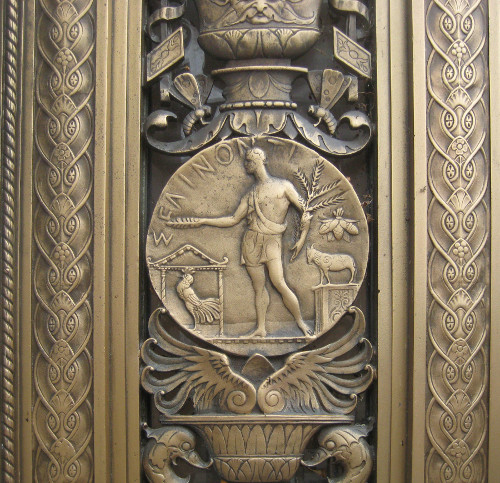
Above the entrance's archway are two symmetrically positioned figures carved in stone. The winged woman on the left is holding up a caduceus - a short, winged staff entwined by two serpents, and the ancient symbol of commerce and negotiation. (The traditional medical symbol, the rod of Asclepius, has a single snake and no wings.)
The winged man on the right holds out a container and keys, symbolizing security. Both figures are resting an arm on a cornucopia, the symbol of abundance - an especially appropriate symbol for an agricultural area. In the spandrels above the flanking arched windows on the front of the building, the figures are holding other symbols such as bolts of lightning with a hammer.
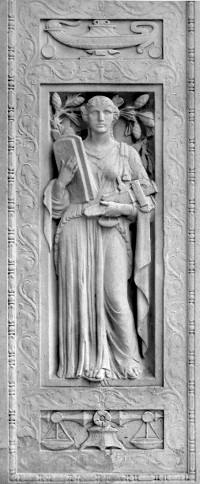 These sculptural reliefs were created by Adolph A. Weinman (1870-1952), one of American's greatest sculptors who specialized in classical figures. The pediment over the entrance to the Jefferson Memorial and the frieze in the courtroom of the U.S. Supreme Court are just two examples of his work. He also designed the Mercury-head-dime and liberty-half-dollar coins.
These sculptural reliefs were created by Adolph A. Weinman (1870-1952), one of American's greatest sculptors who specialized in classical figures. The pediment over the entrance to the Jefferson Memorial and the frieze in the courtroom of the U.S. Supreme Court are just two examples of his work. He also designed the Mercury-head-dime and liberty-half-dollar coins.
In the entrance's reveal are additional figures labeled labor, agriculture, industry, and commerce (on the left) and law, philosophy, soldier, and banking (on the right). One could read these symbols in a straightforward manner. For example, law is represented as a woman holding the two tablets of the Ten Commandments (the Roman numerals one through five are inscribed on the back of the outer tablet) and a sword and scale in the other hand. The scale representing truth and fairness is held behind a sword, which could symbolize the power to enforce the law.
But subtleties are added by additional elements - a plant behind her and a lamp in the frame above her head. Further meaning comes from proportion, placement, the gaze and expression of the figure, etc.
Yet a simple listing of the symbols is less rewarding than viewing the works directly and drawing your own interpretation. Art is, at best, a conversation between you and the artist that grows in meaning as you put time and thought into it.
Bruce Walters is a professor of art at Western Illinois University.
This is part of an occasional series on the history of public art in the Quad Cities. If there's a piece of public art that you'd like to learn more about, e-mail the location and a brief description to BD-Walters@wiu.edu.


